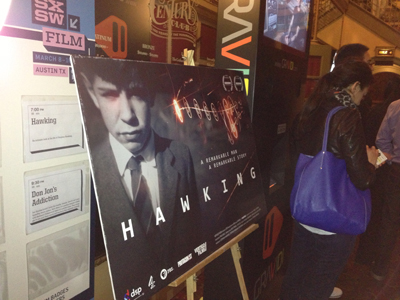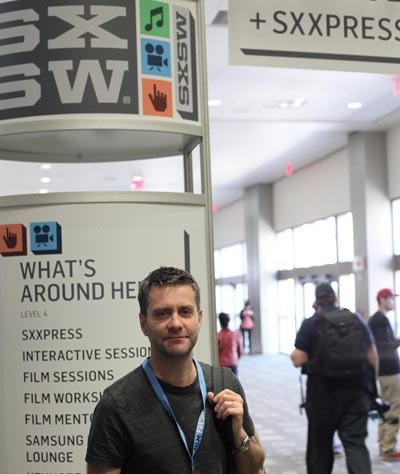Hawking and the New Landscape of Movies

- The disruption of the movie industry is happening on so many levels its impossible to attend a festival like SXSW Film, this week in Austin, and not be amazed (and a little unnerved) by the new ways filmmakers, studios, distributors, critics, and fans are rewriting the rules of how to produce, distribute, and consume movies. There has never been so much disruption, so much creativity, so many new platforms, and so many films being made. Just don’t try to define the movie experience– it’s a moving target. What is a movie, today? Theatrical release? VOD? TV? Convergence of all the above? Yes to all. The old rules of movie making are not dead. But new alternative rules are being written daily– whether for reinventing the pure theatrical experience with new tools like HFR (high frame rate) or bringing simpler tools of moviemaking to the masses via streaming and social media and other democratizing platforms.
Hawking, that had its premier at the SXSW Film festival Monday, March 11th, illustrates some interesting things going in two areas of film.
When it all gets too dizzying at an event like SXSW Film, I just do what industry critics have always done– slip out of those endless panel discussions on convergence and the future of everything, and go catch one of the selected new movies on tap. Occasionally, the movie turns out to be one that illuminates a couple of key dynamics in the new landscape of film. The film Hawking had its premier at the SXSW Film festival Monday, March 11th, and it illustrates some interesting things going in two areas: media chronology, and movie direction in the all-digital domain.
Media Chronology is a term used more in the E.U. than here. But it’s the best way–wherever you work– to describe what is now the most contentious issue in movies: when, where, how, and in what sequence do you release a movie, for public consumption. Traditionally, at least in the U.S., movies were released in a basic sequence that retained its logic and distribution dynamics even as new technology platforms meant tweaking the model along the way. A movie was released first for movie theaters, followed by airline and paid hotel showings, then DVD (or BluRay), then pay-per-view cable, then premium cable (HBO, etc.), then broadcast and basic cable. This multi-tiered strategy offered some exclusivity to each exhibition and distribution company in its particular stage of release, so that each tier had its own “window” to present the film.
That was then. This is now– the new wild west of production, distribution, and exhibition. Once you had the perfect (and ongoing) storm of young filmmakers wanting–wisely– to get their product out ASAP on any platform in sight (and the inexpensive tools to do that), the rise of social media as a marketing tool that can use an early digital release to drum up theatrical release buzz, and what is essentially free bandwidth for all– there was no holding back the floodgates.
In the EU, there is still debate, and attempts at regulation of media chronology regimes to nurture– or better said, preserve– the legacy industry models. But in the U.S. it’s a different game. The rise of Day-and-Date– a release strategy in which a movie enters theaters on the same day as it begins its digital distribution (digital being essentially VOD or Video on Demand now as the DVD is a dying breed) has changed everything.
In fact, Day and Date, has quickly morphed into– what? Day/Date? Date and Day? What do you call the media chronology that has a movie being introduced first to digital/VOD, and then at a later date to theaters? What do you call a release that has no intention of ever placing the work in a theater, but presents only on VOD be that Netflix or YouTube or anything in between? (I won’t even ask, what do you call a movie whose script is crowd-sourced from fans on FaceBook, and whose “release” is not the most important part of the process. There are numerous panel sessions at SXSW this week on crowd-sourcing funding and now content for a film.)
Many films being birthed today– including most of the films being shown at SXSW Film this week– are launched with the hope of getting audience traction anywhere, any way. A VOD-only release deal (anything from Netflix to Hulu) would thrill all but a few filmmakers here at SXSW. But in an interesting twist on the dynamic, a “headliner” film here– a film that is on the surface a traditionally styled production and was chosen by SXSW curators to headline at the festival– is generating buzz from surprising angles.
A daily selection of features, industry news, and analysis for AV/IT professionals. Sign up below.
The buzz around the new film began last month when PBS president Paula Kerger announced that the first-ever autobiographical documentary of physicist Stephen Hawking, called A Brief History of Mine (working title), was slated to air by PBS in 2013. Well, that working title is history, and release plans have taken new turns. The film had its world premier Monday night at SXSW Film, as Hawking. Commissioned originally as a TV production by UK’s Channel 4 and PBS, Hawking is the first film about– according to the press materials– “the planet’s most famous living scientist, told for the first time in his own words and by those closest to him”.
In this age of celebrity, it would be hard to make a documentary film about an iconic figure who has celeb credentials on so many levels–a Nobel Prize, the overcoming of a handicap on heroic terms, the best-selling science author since Carl Sagan, and something of a cultural provocateur pedigree– and not produce a movie that resonates with millions. In a packed house (with mainly film biz insiders and film press) at the historic old Paramount theatre in downtown Austin Monday night, with executive producer Ben Bowie and director Stephen Finnigan in attendance, the film’s reception was very positive. That result was not preordained, despite the subject. The film is not your conventional documentary, celebrity or otherwise. It’s an innovative and somewhat risky blend of three genres (only two of them traditionally film genres). And it demonstrates the use of new technology tools by filmmakers bending rules a bit, to interesting effect.
Hawking blends standard documentary narrative, dramatic recreation, and autobiography to present a different kind of film. It’s certainly not a standard documentary. The movie tells the now largely familiar story of Stephen Hawking’s precocious childhood, his university life at Oxford and Cambridge, and his overcoming of huge physical challenges from his ALS disease, as he accomplished what no scientist has ever done– combine new insights into cosmology, quantum physics, and thermodynamics to rewrite the history of the universe and the laws of physics. Black holes were to Hawking what gravity was to Newton, and he deconstructed them to solidify the Big Bang theory.

Hawking director Stephen Finnigan, at SXSW Film in Austin, on Tuesday.
The story of Hawking’s life is well known and well documented. What’s new in this film? Hawking’s producer/director team decided– in consultation with Stephen Hawking– to use dramatic recreations to tell parts of the narrative for which there was not archival material. It was not as easy decision, to try to blend standard archival interviews, new material, and dramatized sequences. Producer Ben Bowie told me Tuesday at SXSW there was some anxiety as they weighed how the audience would accept this mixing of genres. Indeed, the dramatic recreations– many of them addressing “the early years” whether in adolescence, the early university years, and the first incidents of medical crisis– could have easily brought the entire enterprise down to the level of standard TV drama. But this was averted by both narrative and technical maneuvering that resulted in a cohesive, seamless whole.
“The film started as a documentary,” said executive producer Ben Bowie. “But it became more of an autobiography”.
Indeed, Stephen Hawking is listed in the credits as one of three writers (along with, interestingly, Bowie and Finnigan, pointing out the hybrid nature of this film where subject, producer, and director share writing), raising my curiosity as to whether Stephen Hawking was heavily involved in the script, outside his rather extensive narration. Director Stephen Finnigan told me that in fact Hawking’s writing was limited to the Hawking monologues and voice-overs, and that Finnigan had freedom with the direction. That Hawking’s narration ends up dominating the script is by design. The film did indeed morph from documentary to a literary-style autobiography– a move could have become stylistically messy. But the dramatic recreations of Stephen Hawking’s key early and mid-life provide the directorial thread that blend the two tasks well.
Hawking was shot with a mix of digital cameras. A Canon C300 was used “for the drama and beauty shots” Finnigan said. The many long lingering shots of the Oxford cityscape. And the dramatic recreations peppered throughout– especially the middle of the film. A Panasonic 300 did duty for “fly on the wall” shots that were more documentary in feel (with a Canon Mark III also used for some of those). For the many shots where we see through Stephen Hawking’s eyes as we ride along in his famous motorized wheelchair, the director attached two GoPro’s to Hawking’s rig– one forward looking and seeing the world through Hawking’s eyes, and one with a “handlebar” view of Hawking.
Nothing out of the ordinary there. The Canon C300, with its 4K resolution and its big arsenal of lenses, is a great tool for this kind of filmmaking. Why so here? The most technically and narratively intriguing part of Hawking is how the director handled the dramatic recreations of key episodes of Stephen Hawking’s life– from medical emergencies to eureka moments as Hawking made key breakthroughs in physics. For these shots the direct eschewed traditional directorial approaches and instead used the C300 to seemingly get inside the troubled genius’s head. We see the action from extreme close-up in a lot of these sequences. And I mean extreme. As in the nuances of a fluttering eyelash. Or we see the action from odd angles, with skewed or overemphasized limbs, chins, eyes, elbows.
As Stephen Hawking’s ailing body was being left behind by a racing mind, in key points in his career, Hawking’s mental prowess was increasing, and indeed one of the most intriguing points brought up in the film is the idea that Hawking didn’t arrive at his breakthrough discoveries despite his physical limitations, but often because of them. As one of Hawking’s protégé remarks in the film, Hawking at critical points in his career was able to see “topologies” in physics and cosmology that he was forced onto by being freed or excluded from routine communication paths the normal physicist would have tread down indefinitely. The best parts of the film are indeed the ones that explore the relationship between scientific genius and frail human communication. Not an easy theme for a movie.
One technique director Stephen Finnigan employed to mimic or simulate this kind of alternate mental plane in the dramatic recreations of key biographical episodes is “lens whacking”.
I tell young film interns, the quickest way to get the “film look” with a digital camera, is to use shallow depth of field, even–especially– when there is plenty of ambient light. Long before you could do it with video, fast lenses on 35mm movie cameras let the director control the viewer’s eyes. For decades, video was playing catch-up, and with the inexpensive video rigs it was still hard to get that super-shallow depth with only a face in focus. That’s all changed now as DSLR’s brought all those fast lenses from the still world to the cinema tool bag. But what’s new this year– I’ve seen it in other films at SXSW– is that directors are really pushing the limits here. Razor-thin depth of field. We’re talking, one eye in focus. And we’re talking both razor-thin depth of field, and a focal plane that is not nailed down parallel to the film plane. It’s impossible to overestimate how radical this is technically: manipulating the axis of the focal plane, not just the depth of focus. Welcome to lens whacking. You “unscrew” i.e. decouple the lens from its mount on the camera. Hold it, say, a quarter of an inch out from the mounted position. Tilt it slightly. Fool around. There are more than a few shots in Hawking where the plane of focus seems to be seeking its own level as the scene progresses. The lens, unmoored, may be inches from the actor’s (or Hawking’s) face. You’re close, yet removed. The focus is… there, but it’s not. The plane of focus is veering away from you, not parallel to you. You’re looking into the head of a character, or being walked through a room in new ways by the director. It’s mesmerizing and effective, especially as it’s used here, to transition documentary and talking head footage to summary and expository sequences that achieve that role with imagery that helps along the narration.
Professor Stephen Hawking, at the Department of Applied Mathematics and Theoretical Physics, University of Cambridge.
Hawking– with its clever mix of styles that arrives at a new way to look inside the life of a subject that has been in the public glare for so long– is a powerful film. A bit disturbing. We all forget that Stephen Hawking is in his 70’s now. Hasn’t he always stood, ironically, for us, outside of time, a kind of spry but delicate action figure of science? A boy really, frail, and funny, and mischievous. And ageless. We are brought by these filmmakers to see through to the man “trapped inside a dying body” as are we all, on an intellectual quest of the most profound kind, as the clock ticks down. But the filmmakers bring us full circle, back, again, to a hero’s story and the story of the triumph of the spirit. It’s a winning story, at the end of the day. A bit old-fashioned, in a nice way– in a way that will win audiences.

